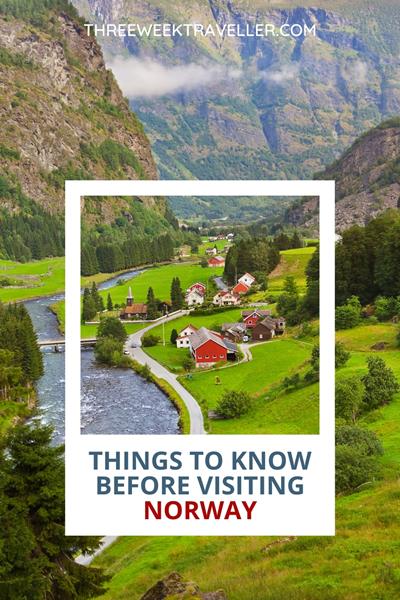Norway is a Nordic country located in Northern Europe in the Scandinavian Peninsula. It is bordered by Sweden to the East, Skagerrak Strait to the South, and Finland and Russia to the Northeast.
Norway is well-known for its fjords, the Northern Lights, Norwegian salmon, Vikings, and more. Plus, if you’re into hiking, it’s an exciting place. You can hike up mountains like Preikestolen for epic views of the fjords, which are these massive, beautiful waterways surrounded by cliffs.
Simply put, 3 weeks in Norway offers cultural and natural wonders to local and international tourists. It is filled with snow-capped mountain peaks and beaches where numerous adventurous activities await.
THINGS TO KNOW BEFORE GOING TO NORWAY
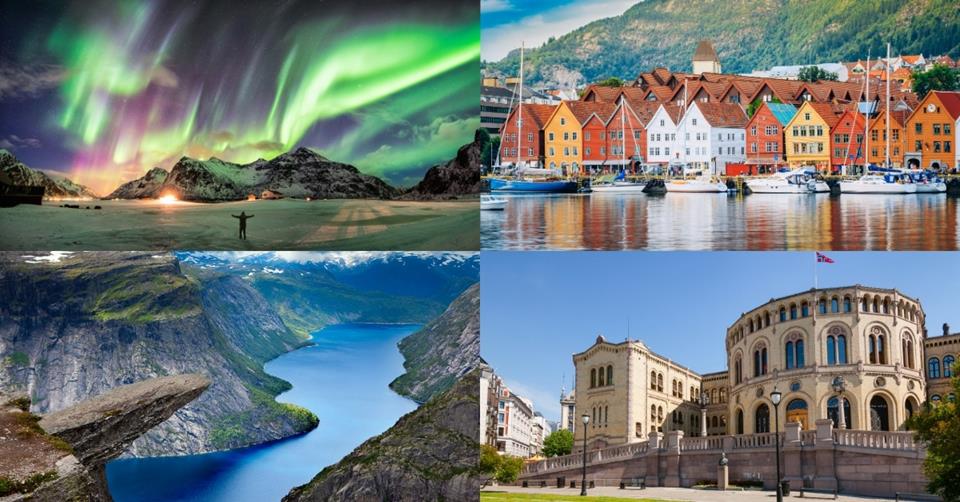
Norway is one of my favourite places to visit because of how easy it is. For a country where English is not the main language, the locals and the government surely made it easy to get around. Here are some other travel information you should know:
When is the best time to go to Norway
The best time to visit Norway is during the summer, from June to August when the weather is warm and the days are long. Peak season is in these summer months, so expect more tourists and higher prices especially since this is also the time the locals are travelling domestically.
The rainy season varies by region, but it’s generally wetter in the autumn. Winter, from November to March, is cold and snowy, perfect for skiing.
The shoulder seasons, May and September, offer milder weather and fewer tourists, making them great times to visit if you prefer avoiding crowds. It’s still a bit cold during these months, but there are less tourists.
Are 3 weeks enough for Norway
20 days is not enough to see all of Norway, but it’s plenty to explore its top sites such as Oslo, Bergen, and the Fjords, and do some hiking. It’s important that you plan to visit cities that are near one another or have easy access or transportation to save time.
What to pack
Even in summer, Norway can be cold at night, so plan to pack at least a lightweight jacket, sweater, or hoodie. If you’re visiting in summer, lightweight and breathable clothing is a good idea. But for spring, autumn, and spring, you want to plan to layer your clothes and bring a scarf and hat to stay warm.
It’s not cheap to buy winter jackets here, so you better bring your own to be comfortable.
How to get around
The best way to get around Norway depends on your priorities. Trains and buses are the most convenient for reaching major cities and offer scenic views. For speed, domestic flights connect major cities quickly.
The most affordable option is often buses, followed by trains, especially with advance bookings. Car rental is a good idea for flexibility and exploring remote areas at your own pace, though it can be pricier due to rental fees and high fuel costs.
Consider your budget, destinations, and whether you value speed, convenience, or scenic routes to decide the best option for you.
Language and currency
The main language in Norway is Norwegian. Yes, tourists can easily get around using English, as it’s widely spoken throughout the country. Most Norwegians, especially in urban areas and tourist spots, speak English fluently.
Signs, menus, and information in tourist areas are often available in English as well. Communicating in English should pose no significant issues for visitors, making it convenient for English-speaking tourists to explore the country, interact with locals, and enjoy their travel experience in Norway.
The main currency in Norway is the Norwegian Krone (NOK). Tourists cannot usually pay with other major currencies like USD or EUR in most places. Card payments are widely accepted and preferred over cash in Norway, including in shops, restaurants, and public transport.
Many Norwegians live almost cashlessly, using cards or mobile payment apps for transactions. It’s advisable for tourists to use cards or mobile payments for convenience and to withdraw or exchange a small amount of cash for places that might not accept cards.
Average travel cost for Norway
Norway is an expensive destination, that’s a common fact. But it doesn’t mean you’ll have to shell out too much. With good planning, you can still travel on a budget and book everything in advance or plan your trip outside the peak season.
Here are some cost ranges for spending 3 weeks in Norway:
- Affordable: Budget travellers can expect to spend around $1,500 to $2,000. This includes staying in hostels, using public transportation, eating at inexpensive places, and enjoying free activities.
- Mid-range: For a more comfortable experience with private accommodations, some restaurant meals, and domestic travel, the cost is about $3,000 to $5,000.
- Luxury: Luxury travellers looking for high-end hotels, fine dining, private tours, and exclusive experiences might spend upwards of $8,000 to $12,000 or more.
These estimates include accommodation, transportation, food, and activities but exclude international airfare. Prices in Norway can be high, so planning and budgeting according to your travel style is important.
Visa
Norway is actually not part of the EU, but it is a member of the Schengen State. It can be confusing since the Schengen Area is the most successful product of the EU. Anyway, this means that Norway implements the same visa policy as the EU.
For travellers with a passport from Australia, Japan, New Zealand, South Korea, Malaysia, Singapore, and most places in America, you can enter and travel to Norway without a visa and stay for up to 90 days (or in the Schengen Area collectively).
Other nationalities must apply for the Schengen visa through the Norwegian Embassy or Consulate near you.
Other travel tips
PINNED MAP OF MUST-SEE PLACES IN NORWAY
Click the enlarge button on the top right corner. Credit: map data: Google
TRIP COST CALCULATOR
Trip Cost Calculator
Your Budget:Number of Days:
How Many are Travelling:
Total Flight Cost:
Travel Insurance:
Daily Transport Budget:
Daily Activity Budget:
Daily Hotel Budget:
Daily Food and Drinks Budget:
Others/Miscellaneous Budget:
3 WEEKS IN ITINERARY
Aside from the rugged coastline and mountains, Norway has numerous expansive museums. With everything it offers, staying in Norway for at least 20 days is ideal.
There are also a couple of fjords spread out all over the country, so if you can’t visit one in a specific location, you could do so on your next destination as long as you get to the coast.
This is an overall slow travel itinerary, so the modes of transport depend on your preference. You can rent a car if you prefer privacy and flexibility regarding travel times. There are also tons of public transport available here for those who prefer less expensive options, including buses, trains, tramways, and ferries.
On the other hand, maybe you want to spend 3 weeks in Scandinavia instead which covers Norway, Denmark and Sweden in one trip.
Package Tours
Oslo for 5 days
Oslo is the capital and the most populous city in Norway. It is classified as both a county and a municipality.
This city is well-known for its modern design, architecture, fjords, and forest landscapes, so this place perfectly balances nature and a scenic city vibe. Aside from that, Oslo is said to be the birthplace of modern skiing, specifically in Morgedal.
It is the perfect place to start your trip because its airport accommodates domestic and international flights. There are also tons of car rental shops here for those who prefer to use cars as modes of transportation.
Aside from multiple must-see places here, they also have day tours to Hadeland Glassverk, Kistefos Museum and Sculpture Park, Edisvoll, and more.
Things to do in Oslo
- Go sightseeing around Oslo through a bike tour or hop-on, hop-off bus tour or walking tour or island hopping walking tour or discovery tour or a food tour
- The Royal Palace
- Grunerlokka
- Norwegian Mining Museum
- Holmenkollen Ski Jump
- Heddal Stave Church
- Gon on a Fjord cruise – either on a catamaran boat or traditional Viking ship or on an evening cruise with a buffet or a 3-course dinner cruise or city tour with Fjord cuise
- The Oslofjord
- The Opera House
- Try a traditional Norwegian sauna – on a fliating boat
- Akershus Fortress
- Day trip to Sognefjord – full-day tour with a Flam Railway or 22-hour tour
Accommodations in Oslo
- Budget-friendly: Bunks at Rode or HI Oslo Haraldsheim
- Mid-priced: Kollen Slottet or Voksenasen Hotel or Citybox Oslo
- Lavish: Hotel Bristol or Radisson RED Oslo Økern or Thon Hotel Storo or Thon Hotel Rosenkrantz Oslo
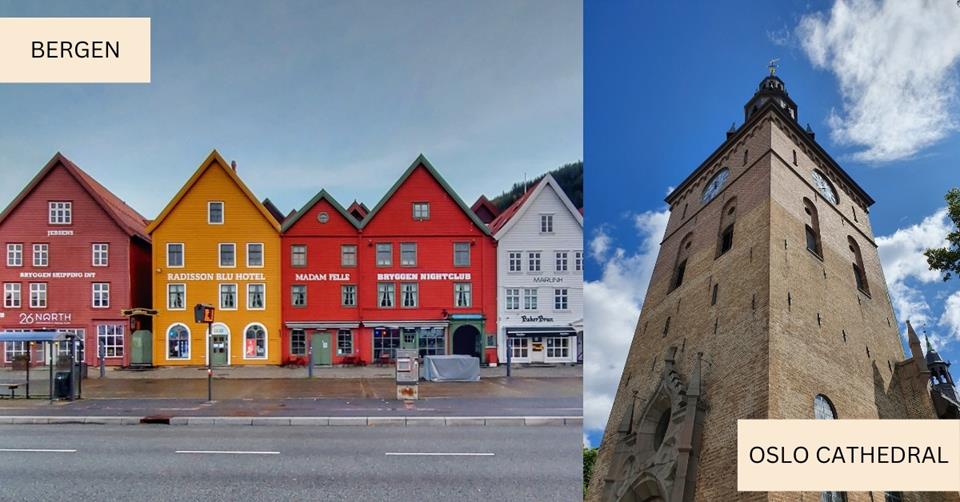
Stavanger for 3 days (Pulpit Rock)
Stavanger is the third-largest city and third-largest metropolitan area in Norway. I recommend staying here for at least 3 days for those waiting for three weeks in Norway. Stavanger is known for having the most extensive collection of wooden houses in Northern Europe, found in the old town of Gamle.
Aside from that, Stavanger is also a bus ride away from Preikestolen and Kjeragbolten, which are both natural wonders that can be hiked in a day. It also houses Solastranden, named one of the world’s most beautiful beaches.
The distance between Oslo and Stavanger is 547.7 km. To reach Stavanger in record time, you must ride the train to Oslo Lufthavn Stasjon, fly, and then ride the bus from Sola to Stavanger.
The travel time for this is 3 hours. Other options include riding the bus, which has a travel time of 8 hours, riding the train, night train, or driving.
Things to do in Stavanger
- Lysefjord – there’s a Fjord cruise with Preikestolen side trip or there’s also a kayaking tour for Lysefjord or the unique RIB boat tour
- Petroleum Museum
- Stavanger Museum of Natural History
- Explore Stavanger through a hop-on, hop-off bus tour
- Norwegian Printing Museum
- Over Holmegate
- Day trip to Preikstolen – see the tour reviews and cost or a sunrise hike with breakfast or this hike to Preikestolen
- Annual NuArt Festival
- Gladmat food festival
- Fjord Cruise
- Day trip to Haugesund – including Akrafjorden and Langfoss waterfall
Accommodations in Stavanger
- Budget-friendly to Mid-priced: Central Guest House or Central Economic Stavanger Brødregata or Cozee Central Apartments
- Lavish: Ydalir Hotel or Hotel Victoria or Radisson Blu Atlantic Hotel
Bergen and Floyen for 4 days (Fjords)
You cannot plan 3 weeks in Norway vacation without visiting Bergen. It’s is a city and municipality in Vestland County on the West coast of Norway. It is also known as the city of seven mountains because it is surrounded by mountains.
It is considered one of the UNESCO sites in the country and is known to be home to some of the world-renowned classical composers, including Ole Bull and Edvard Kreig. It is also well-known for its nightlife and being a gateway to the fjords, plus the traditional colourful houses.
Floyen is one of the seven mountains surrounding Bergen and is perfect for hiking and checking out the panoramic views. They offer walking tours with various duration and hardship levels and bicycle rentals. They also have a climbing park and zipline.
The distance between Stavanger and Bergen is 207.5 km. There are numerous ways to get to Bergen if you’re coming from Stavanger. The fastest is by flying, which has a travel time of 40 minutes. Other options include riding the Fjord Line ferry, taking a bus, or driving.
Things to do in Bergen and Floyen
- Fjord Cruise to Mostraumen, the most popular Fjord in Norway or one with Mostraumen and a waterfall stop or a Fjord cruise to Alversund Strait
- Day trip to the famous Trolltunga
- Hanseatic Museum
- Kayak to Oygarden Islets – check the tour cost
- Mount Floyen trail hike
- Naeroyfjorden – there’s a cruise tour with Falm and Stegastein stops
- Kode Museums
- Norwegian fishing – there’s a fishing tour you can book
- Bergenhus Fortress
- Day trip to Hardangerfjord – read the tour reviews
- Vilvite and the Aquarium
- Day trip to Oslo – this will save you time
- Canoe paddling
- Explore Bergen via a hop-on, hop-off bus or walking tour through the past and present or minibus with a Bryggen tour or a segway tour
Accommodations in Bergen and Floyen
- Budget-friendly: Citybox Bergen Danmarksplass or Bergen Hostel Montana or City Hostel Bergen
- Mid-priced: Klosterhagen Hotel or Keyser Apartments 6 or Radisson Blu Royal Hotel
- Lavish: Opus 16 or Charmante – Skostredet Hôtel or Keyser Apartments 8 or Hotel Park Bergen
Alesund for 3 days (Fjords)
Alesund is the 13th most populous city in Norway. It is known for its concentration on Art Noveau architecture. It is also surrounded by a diverse and magical landscape that makes Alesund look like a city straight from a postcard. It is considered to be the most beautiful fjord city.
Aside from its incredible scenery, Alesund offers numerous activities such as kayaking, Hiking, SUP boarding, or e-bike city tours. With all these things and more, I suggest you stay for at least 3 days in Alesund if you spend 3 weeks in Norway.
The distance between Bergen and Alesund is 421.8km and has a driving time of more than 7 hours. Other options include riding the bus or the ferry. The fastest option would be to fly, with a travel duration of almost 4 hours.
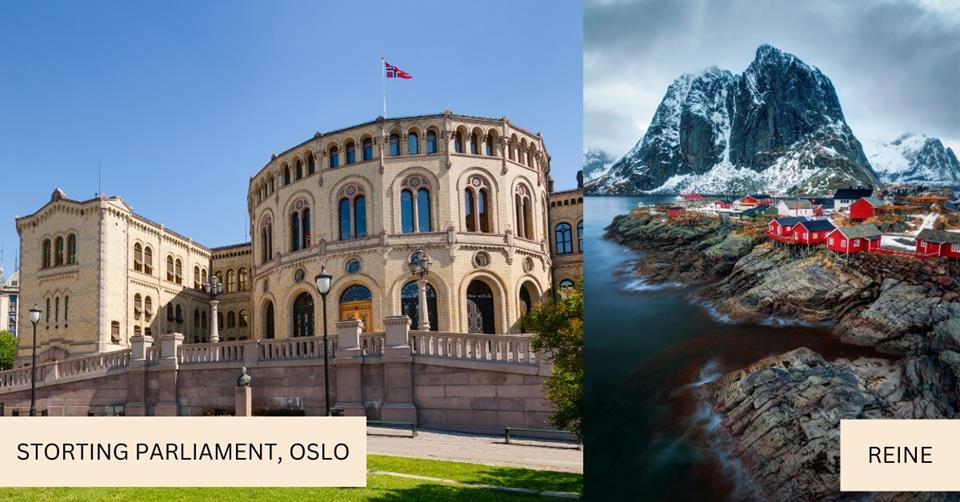
Things to do in Alesund
- Explore Alesund – through a hop-on, hop-off bus tour or a half-day tour
- Atlantic Sea Park
- Alesund Museum
- Trollstigen – choose between a shore excursion and land tour or a land tour with Fjords
- Alnes Lighthouse
- Hike up Slogen
- Boat trip to Hjorundfjord
- Go rock climbing – check out this ferrata tour
- Go kayaking
- Geirangerfjord – there’s a day cruise from Alesund or a Fjord cruise in winter
- Ski touring
- Art Nouveau Center
- Do an island hopping – read the tour reviews
Accommodations in Alesund
- Budget-friendly: Cozy Retreat in the Heart of Ålesund
- Mid-priced: Hotel Noreg or Scandic Parken or Quality Hotel Ålesund
- Lavish: Hotel 1904 or Hotel Brosundet
Tromso for 5 days (Fjords)
Tromso is the 12th largest municipality in Norway. It houses the world’s northernmost planetarium, university, and botanical garden. It is well-known for its magnificent ice domes and fjords and is known to be among the best locations to witness the Northern Lights.
There is an annual Northern Lights festival here, and one of the cruise lines offers an aurora supper cruise.
Aside from that, Tromso is also where you’ll experience the midnight sun and polar night phenomenon. With all of that being said, Tromso is indeed an otherworldly place.
Alesund is quite far from Tromso, with a distance of 1,423.9 km, so I recommend flying to reach Tromso faster. The travel time for this is more than 5 hours, and tickets cost anywhere between $113 to $330. Other modes of transportation are riding the bus and then train, riding the ferry, or driving, but all of these have more than 24-hour travel durations.
Things to do in Tromso
- Polaria, the northernmost aquarium
- Go on a Fjord cruise – midnight cruise or cruise with Kvaloya Island and lunch or on a Catamaran boat
- Fjellheisen cable car
- See the Northern Lights – there are a lot of tours for this, so check which one you like the most: Tour 1 – Tour 2 – Tour 3 – Tour 4
- Whale-watching fjord tour
- Reindeer sledding
- Bird-watching – while on a Fjord cruise with lunch (family-friendly)
- Tromso Ice Domes
- Explore Tromso – with a tour around Fjord, islands, and Sommaroy or a midnight concert at Tromso Cathedral or on a half-day bus tour
- The Polar Museum
- Snowshoeing or Reindeer sledding or husky sledding – this is a must-do tour in Norway in winter
- Day trip to Senja and Kvaloya Arctic – see the tour cost
Accommodations in Tromso
- Budget-friendly: Tromso Coco Apartments or Comfort Hotel Xpress
- Mid-priced: Skaret by Vander or Moxy Tromso or Enter Backpack Hotel
- Lavish: Clarion Hotel the Edge or Ami Hotel or Radisson Blu Hotel
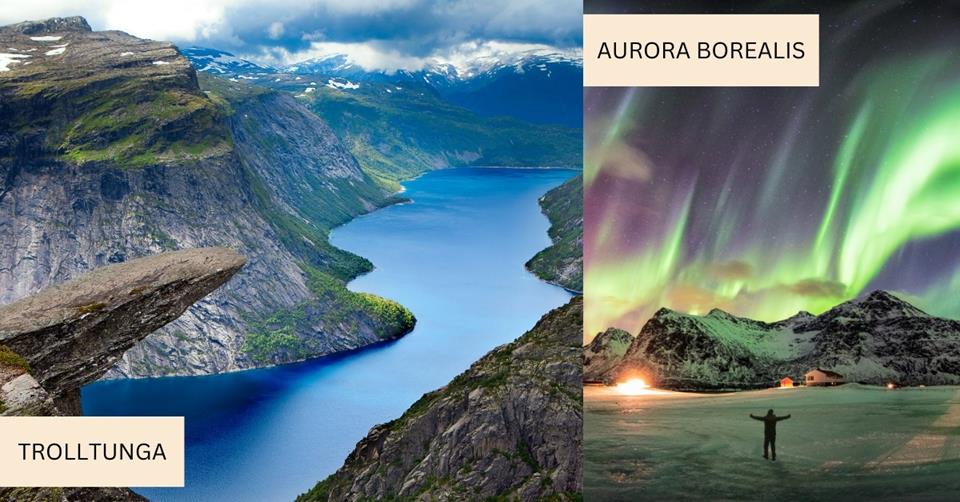
BONUS: Svalbard
If you’re up for more, you can go to Svalbard. It is a Norwegian Archipelago in the Arctic Ocean. It is a separate island and must-visit because you can see polar bears here, bird species are abundant, they offer exclusive wildlife tours, and you can also visit the northernmost brewery, Svalbard Bryggeri.
There are also tons of activities to do here, like going on a safari, exploring ice caves, snowmobile tours, dog sledging, visiting the Global Seed Vault, exploring ice caves, and more.
TIP: If you go here, you can skip Alesund and spend fewer days in Oslo and Tromso.
MUST-TRY NORWEGIAN DISHES AND DRINKS
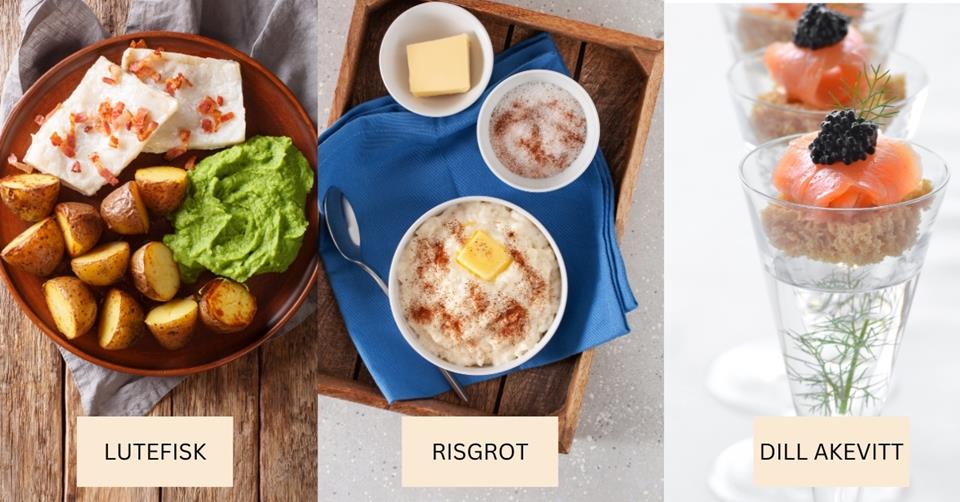
If you have travelled to other Scandinavian or Nordic countries, the food in these places is quite similar, although each of them has its own versions. Here’s a quick list of dishes and drinks to try from Norway:
- Rakfisk – Fermented fish, often trout or char, served with flatbread and sour cream.
- Fårikål – Mutton and cabbage stew, seasoned with whole black pepper and often served with potatoes.
- Kjøttkaker – Norwegian meatballs, usually served with gravy, potatoes, and lingonberry jam.
- Lutefisk – Dried whitefish (usually cod, but ling and haddock are also used) rehydrated and cooked with lye, often served with peas and bacon.
- Rømmegrøt – Sour cream porridge, a rich and tangy dish, often served with sugar, cinnamon, and butter.
- Pinnekjøtt – Dried and salted lamb ribs, rehydrated and steamed, served as a traditional Christmas dinner.
- Smalahove – Smoked sheep’s head, traditionally eaten before Christmas.
- Brunost – Brown cheese, a sweet, caramel-like cheese made from the whey of goat’s milk.
- Krumkake – Thin, rolled cake similar to a waffle, filled with whipped cream or other fillings.
- Risgrøt – Rice porridge, often served with sugar, cinnamon, and butter, and sometimes served as a Christmas dessert.
- Multekrem – Dessert made of cloudberries and whipped cream, sweet and tangy.
- Akevitt (Aquavit) – A distilled spirit that is often flavoured with herbs such as caraway seeds; it’s a traditional Norwegian spirit.
- Kaffe – Norwegians love their coffee, often enjoy black, and it’s an integral part of daily life.
- Mjød (Mead) – An ancient drink made from fermented honey, experiencing a resurgence in popularity in Norway.
SUMMARY OF 3 WEEKS IN NORWAY
Norway is a nature lover’s haven through and through, with its fjords, mountains, and quaint fishing villages. However, that’s not all there is in Norway.
It has numerous trendy cities and well-preserved cultural heritage, and of course, let’s not forget the countless snow-related activities, festivals for those who prefer adrenaline-filled activities and the hustle and bustle of crowds.
Whatever your preferences are, you can experience them in this country. That’s why I highly advise staying for at least 3 weeks in Norway because it has so much to offer.
SAVE THIS TRAVEL ITINERARY ON YOUR PINTEREST:
